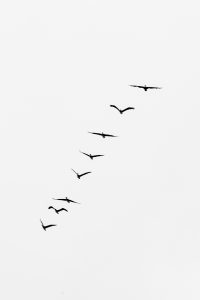 As we move into fall, the birds begin their move for the winter.
As we move into fall, the birds begin their move for the winter.
Although there are still plenty of American Goldfinch and Northern Cardinal young begging for food, most of this year’s hatchlings are now fully independent of mom and dad and are footloose and fancy free. As young disperse from their home base, the need for territories disappears, and adult movements expand.
Common Grackles, Red-winged Blackbirds, Blue Jays, and European Starlings hang out in flocks over the winter, and you may have noticed them gathering.
The shortening day length triggers what’s called migratory restlessness in bird species that head south for the winter. This irresistible pull from the south means movement will start soon, if not already.
Hawks and vultures migrate by day, riding thermals and soaring southwards, but songbirds travel at night, because it’s cooler, they’re less likely to be detected by predators, and they use the night sky (among other cues) to navigate. If you stand outside after dark, you might even hear the occasional contact call from overhead as birds within migratory flocks stay in touch with one another while they move.
Spring and fall migration are great times for backyard bird watching as new and different species pass through, but migration is risky business and a lot of work for the birds. Here are a few things you can do to help them out:
- Keep your bird feeders well-stocked with high-quality fresh food. Hulled seed reduces the effort – and therefore energy – needed to eat. If you want fewer grackles, this is a good time to put out our squirrel-free blend or safflower.
- Offer them fresh water with a bird bath.
- Keep your cats indoors (cats are one of the main causes of bird mortality).
- Put decals on your windows to reduce the likelihood that birds will fly into them.
